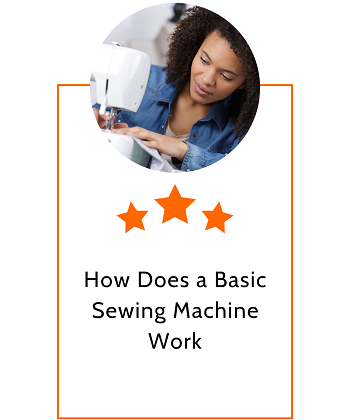
As you work on your sewing projects, have you ever asked yourself how does a basic sewing machine works? If you are like me, then you must have.
Technically, the basic operation of the modern sewing machine has not changed as compared to the first inventions.
If you look at how a stitch is formed, the exact same principle is used, involving the upper thread, which comes from the thread spool above, and the lower thread, which comes from the bobbin below.
In order to understand this better, below is a detailed description of the workings of the most basic part of a sewing machine.
Main Parts Involved
Before looking at how this equipment works, here are the main parts that are involved in this process:
- Bobbin
- Thread tensioning discs
- Needle
- Feed dog
- Presser foot
- Shuttle hook
- Electric motor
How a Basic Sewing Machine Works
Needle Movement
What you see is the needle starting off at a high position, then moving down the fabric and back up again as you run the machine or as you step on the foot pedal.
What you do not see is the needle feeding the thread that passes through its eye to the hidden mechanism below so as to form a stitch.
Stitch Formation
With the needle driving down through the fabric so as to reach the low position, it creates the hole through which the thread will pass, then feeds its thread to a rotating shuttle hook in the bobbin compartment while at the lowest position just before going up.
This shuttle hook spins and loops the needle thread around the bobbin spool thread, causing them to interlock and thus, create a lock stitch over the fabric that ties it together.
Stitch tightening
As the needle begins to go up, it tightens the thread and consequently, tightens the stitch by pulling up the thread that it supplied down there. Thread tensioning discs along the threaded upper part of the machine also helps in keeping the needle thread tight so that the stitches created our firm.
Fabric movement
Everything is interconnected in these machines and as soon as the needle rises above the fabric, a set of feed dogs pull it in at an even speed so that all the stitches formed later on have the same length.
To give these feed dogs the required grip, a presser foot above presses the fabric tightly over them, enabling their teeth to grab onto the material and move it almost effortlessly.
Repeat the above steps
Once complete, this cycle occurs, again and again, creating a continuous lock stitch, and can only be stopped by letting go of the foot pedal, an empty spool, or an empty bobbin.
Some variations
Modern sewing machines feature several types of stitch patterns and using the zigzag stitch as an example, instead of the needle piercing through in a straight line, it shifts position after every cycle to the left and then right, depending on the width set, and this forms the different pattern.
Conclusion
Of course, running all these parts requires some rotary motion and an electric motor provides this. Older models used treadles but these are rarely used nowadays due to the manual work required.